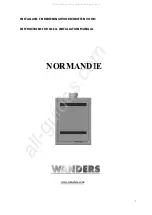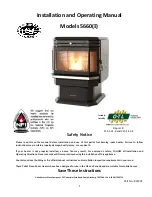
Operator Instructions
Safety
Chimney Smoke and Creosote Formation
When wood is burned slowly, it produces tar and other organic vapours, which combine with expelled moisture to form creosote.
The creosote vapours condense in the relatively cool chimney flue of a slow burning fire. As a result, creosote residue accumulates
on the flue lining. When ignited, this creosote makes an extremely hot fire. The chimney connector and chimney should be inspected
periodically (at least once every two months) during the heating season to determine if a creosote buildup has occurred. If creosote
has accumulated (3 mm. or more), it should be removed to reduce the risk of a chimney fire.
1. Highest smoke densities and emissions occur when a large amount of wood is added to a bed of hot coals and the air inlet is
closed. The heated wood generates smoke, but without ample air, the smoke cannot burn. Smoke-free, clean burning requires
small fuel loads, two or three logs at a time or 1/4 to 1/2 of fuel load and leaving the air inlet relatively wide open, especially during
the first 10 to 30 minutes after each loading, when most of the smoke generating reactions are occurring. After 30 minutes or so,
the air inlet can be turned down substantially without excessive smoke generation. Wood coals create very little creosote-produc-
ing smoke.
2. The cooler the surface over which the wood smoke is passing, the more creosote will be condensed. Wet or green wood contrib-
utes significantly to creosote formation as the excess moisture that is boiled off cools the fire, making it difficult for the tars and
gases to ignite, thus creating dense smoke and poor combustion. This moisture-laden smoke cools the chimney, compounding
the problem by offering the smoke the ideal place to condense.
In summary, a certain amount of creosote is inevitable and must be lived with. Regular inspection and cleaning is the solution. The use
of dry, seasoned wood and ample combustion air will help to minimize annoying smoke emissions and creosote buildup.
Chimney Fires
The result of excessive creosote buildup is a chimney fire. Chimney fires are dangerous. Chimney inside temperatures can exceed
2000° F(1100°C). This causes much higher than normal temperatures in the chimney and on its exterior surfaces. Thus ignition of
nearby or touching combustible material is more likely during a chimney fire. Proper clearances are critical during such a fire.
Chimney fires are easy to detect; they usually involve one or more of the following:
-Flames and sparks shooting out of the top of the chimney
-A roaring sound
-Vibration of the chimney
In Case of a Chimney Fire
1. Prepare to evacuate to ensure everyone's safety. Have a well understood plan of action for evacuation. Have a place outside
where everyone is to meet.
2. Close air inlet on stove.
3. Call local fire department. Have a fire extinguisher handy. Contact your local municipal or provincial fire authority for further infor-
mation on how to handle a chimney fire. It is most important that you have a clearly understood plan on how to handle a chimney
fire.
4. After the chimney fire is out, the chimney must be cleaned and checked for stress and cracks before starting another fire. Also
check combustibles around the chimney and the roof.
- The services of a competent or certified installer, (certified by the Wood Energy Technical Training program (WETT) - in Canada,
Hearth Education Foundation (HEARTH) - in U.S.A.,) are strongly recommended.
Avoiding a Chimney Fire
There are two ways to avoid chimney fires:
1. Do not let creosote build up to a point where a big chimney fire is possible.
2. Do not have fires in the heater that may ignite chimney fires. These are hot fires, such as when burning household trash, card-
board, Christmas tree limbs, or even ordinary fuel wood; (e.g. with a full load on a hot bed of coals and with the air inlet exces-
sively open.)
NOTE: WE STRONGLY RECOMMEND THAT SMOKE AND CARBON MONOXIDE DETECTORS BE INSTALLED IN
THE AREA WHERE THE HEATER IS TO BE INSTALLED.
If smoke detectors have been previously installed, you may notice that they are operating more frequently. This may be due to curing
of stove paint or fumes caused by accidentally leaving the fire door open. Do not disconnect the detectors.
4
290816-24_ NEO 1.2
5055.600-A





































